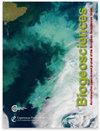Diel and seasonal methane dynamics in the shallow and turbulent Wadden Sea
IF 3.9
2区 地球科学
Q1 ECOLOGY
引用次数: 0
Abstract
Abstract. The Wadden Sea is a coastal system along the fringe of the land–sea borders of Denmark, Germany and the Netherlands. The Wadden Sea is extremely productive and influenced by strong variations in physical and biological forcing factors that act on timescales of hours to seasons. Productive coastal seas are known to dominate the ocean's methane emission to the atmosphere, but knowledge of controls and temporal variations in methane dynamics in these vastly dynamic systems is scarce. Here we address this knowledge gap by measuring methane inventories and methanotrophic activity at a temporal resolution of 1 h over a period of 2 d, repeatedly during four successive seasons in the central Dutch Wadden Sea. We found that methane dynamics varied between colder and warmer seasons, with generally higher water column methane concentrations and methanotrophic activity in the warmer seasons. The efflux of methane to the atmosphere was, on the other hand, lower in the warmer seasons because of lower wind speeds. On a diel scale, tides controlled methanotrophic activity, which increased ∼40 % at low tide compared to high tide. We estimate that methane oxidizing bacteria reduce the methane budget of the Dutch Wadden Sea by only 2 %, while ∼1/3 escapes to the atmosphere and ∼2/3 are flushed out into the open North Sea at ebb tide. Our findings indicate that tides play a key role in controlling methane dynamics and methanotrophic activity and highlight the importance of high-resolution and repeated sampling strategies to resolve methane dynamics in fast-changing coastal systems.瓦登海浅海和湍流中的Diel和季节性甲烷动态
摘要瓦登海是沿着丹麦、德国和荷兰陆海边界边缘的海岸系统。瓦登海的生产力极高,并受到物理和生物强迫因素的强烈变化的影响,这些因素在小时到季节的时间尺度上起作用。众所周知,生产力丰富的沿海海洋主导着海洋向大气排放的甲烷,但在这些巨大的动态系统中,甲烷动力学的控制和时间变化的知识很少。在这里,我们通过在荷兰瓦登海中部连续四个季节重复测量甲烷库存和甲烷营养活动,在一个2天的时间分辨率为1小时,来解决这一知识差距。研究发现,甲烷动态在冷暖季节之间存在差异,暖季水柱甲烷浓度和甲烷营养活性普遍较高。另一方面,由于风速较低,在温暖的季节,甲烷向大气的流出量较低。在昼夜尺度上,潮汐控制着甲烷营养活动,在退潮时比涨潮时增加了~ 40%。我们估计,甲烷氧化细菌仅使荷兰瓦登海的甲烷预算减少2%,而约1/3逃逸到大气中,约2/3在退潮时被冲进开阔的北海。我们的研究结果表明,潮汐在控制甲烷动力学和甲烷氧化活动中起着关键作用,并强调了高分辨率和重复采样策略对于解决快速变化的沿海系统中甲烷动力学的重要性。
本文章由计算机程序翻译,如有差异,请以英文原文为准。
求助全文
约1分钟内获得全文
求助全文
来源期刊

Biogeosciences
环境科学-地球科学综合
CiteScore
8.60
自引率
8.20%
发文量
258
审稿时长
4.2 months
期刊介绍:
Biogeosciences (BG) is an international scientific journal dedicated to the publication and discussion of research articles, short communications and review papers on all aspects of the interactions between the biological, chemical and physical processes in terrestrial or extraterrestrial life with the geosphere, hydrosphere and atmosphere. The objective of the journal is to cut across the boundaries of established sciences and achieve an interdisciplinary view of these interactions. Experimental, conceptual and modelling approaches are welcome.
 求助内容:
求助内容: 应助结果提醒方式:
应助结果提醒方式:


